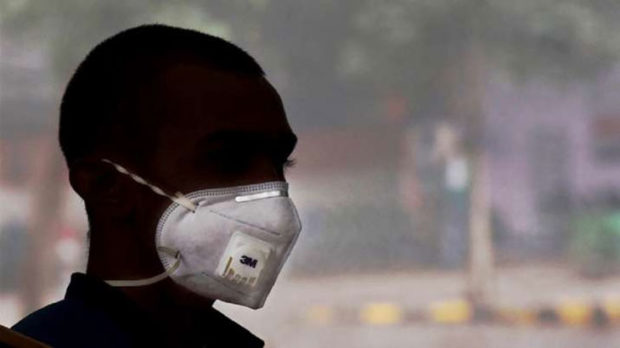
Face masks with exhale valves may hamper Covid-19 mitigation efforts: Study
PTI, Sep 2, 2020, 5:26 PM IST

Image for representation
Washington: Face masks with exhale valves and face shields may not be as effective as regular masks in restricting the spread of aerosol droplets, and could potentially hamper Covid-19 mitigation efforts, researchers, including those of Indian origin, have found.
The scientists from Florida Atlantic University in the US used qualitative visualisations to test how face shields and masks with valves perform in impeding the spread of aerosol-sized droplets.
They found that widespread public use of these alternatives to regular masks could potentially have an adverse effect on mitigation efforts.
For the study, published in the journal Physics of Fluids, the researchers employed flow visualisation in a laboratory setting using a laser light sheet, and a mixture of distilled water and glycerin to generate the synthetic fog that made up the content of a cough-jet.
They visualised droplets expelled from a mannequin’s mouth while simulating coughing and sneezing.
By placing a plastic face shield and an N95-rated face mask with a valve, the researchers including Siddhartha Verma, lead author and an assistant professor at Florida Atlantic University, were able to map out the paths of droplets and demonstrate how they performed.
Results of the study show that although face shields block the initial forward motion of the jet, the expelled droplets move around the visor with relative ease and spread out over a large area depending on light ambient disturbances, the researchers said.
Visualisations for the face mask equipped with an exhalation port indicate that a large number of droplets pass through the exhale valve unfiltered, which significantly reduces its effectiveness as a means of source control, they said.
“From this latest study, we were able to observe that face shields are able to block the initial forward motion of the exhaled jet, however, aerosolised droplets expelled with the jet are able to move around the visor with relative ease,” said Manhar Dhanak, a professor, and co-author of the paper.
“Over time, these droplets can disperse over a wide area in both lateral and longitudinal directions, albeit with decreasing droplet concentration,” Dhanak said.
To demonstrate the performance of the face shield, researchers used a horizontal laser sheet in addition to a vertical laser sheet revealing how the droplets cross the horizontal plane.
Not only did the researchers observe forward spread of the droplets, they found that droplets also spread in the reverse direction.
The researchers noted that face shields impede forward motion of the exhaled droplets to some extent, and masks with valves do so to an even lesser extent.
However, once released into the environment, the aerosol-sized droplets get dispersed widely depending on light ambient disturbances, they said.
Like the N95-rated face mask used in this study, other types of masks such as certain cloth-based masks that are available commercially also come equipped with one to two exhale ports, located on either side of the facemask.
The N95-rated face mask with the exhale valve used in this study had a small amount of exhaled droplets that escaped from the gap between the top of the mask and the bridge of the nose, the researchers said.
The exhalation port significantly reduced the effectiveness of the mask as a means of source control, as a large number of droplets passed through the valve unfiltered and unhindered, they said.
“There is an increasing trend of people substituting regular cloth or surgical masks with clear plastic face shields as well as using masks that are equipped with exhalation valves,” said Verma.
“A driving factor for this increased adoption is better comfort compared to regular masks. However, face shields have noticeable gaps along the bottom and the sides, and masks with exhalation ports include a one-way valve which restricts airflow when breathing in, but allows free outflow of air,” he explained.
Verma added that the inhaled air gets filtered through the mask material, but the exhaled breath passes through the valve unfiltered.
The researchers said that the key takeaway from the study illustrates that face shields and masks with exhale valves may not be as effective as regular face masks in restricting the spread of aerosolised droplets.
Despite the increased comfort that these alternatives offer, they say it may be preferable to use well-constructed, high quality cloth or surgical masks that are of a plain design, instead of face shields and masks equipped with exhale valves.
Udayavani is now on Telegram. Click here to join our channel and stay updated with the latest news.
Top News

Related Articles More

Scientists say India’s ‘Deep Sea Mission’ on track; hydrothermal vent discovery just the beginning

ISRO to launch SpaDeX Mission on Dec 30

ISRO to study how crops grow in space on PSLV-C60 mission

ISRO & ESA agree to cooperate on astronaut training, mission implementation

Snatcher lands in police net in Delhi, AI tech helps reveal identity
MUST WATCH
Latest Additions

Parliament’s Waqf panel dissatisfied with responses from Karnataka, MP, Rajasthan

British rulers distorted India’s history, says Mohan Bhagwat

Rs 2 cr-worth fake accessories with logo of leading smartphone-maker seized

Simran Singh, radio jockey with 7 lakh followers on Instagram, dies by suicide in Gurugram
Gas Cylinder Explosion Claims Two Lives in Ullal
Thanks for visiting Udayavani
You seem to have an Ad Blocker on.
To continue reading, please turn it off or whitelist Udayavani.






















